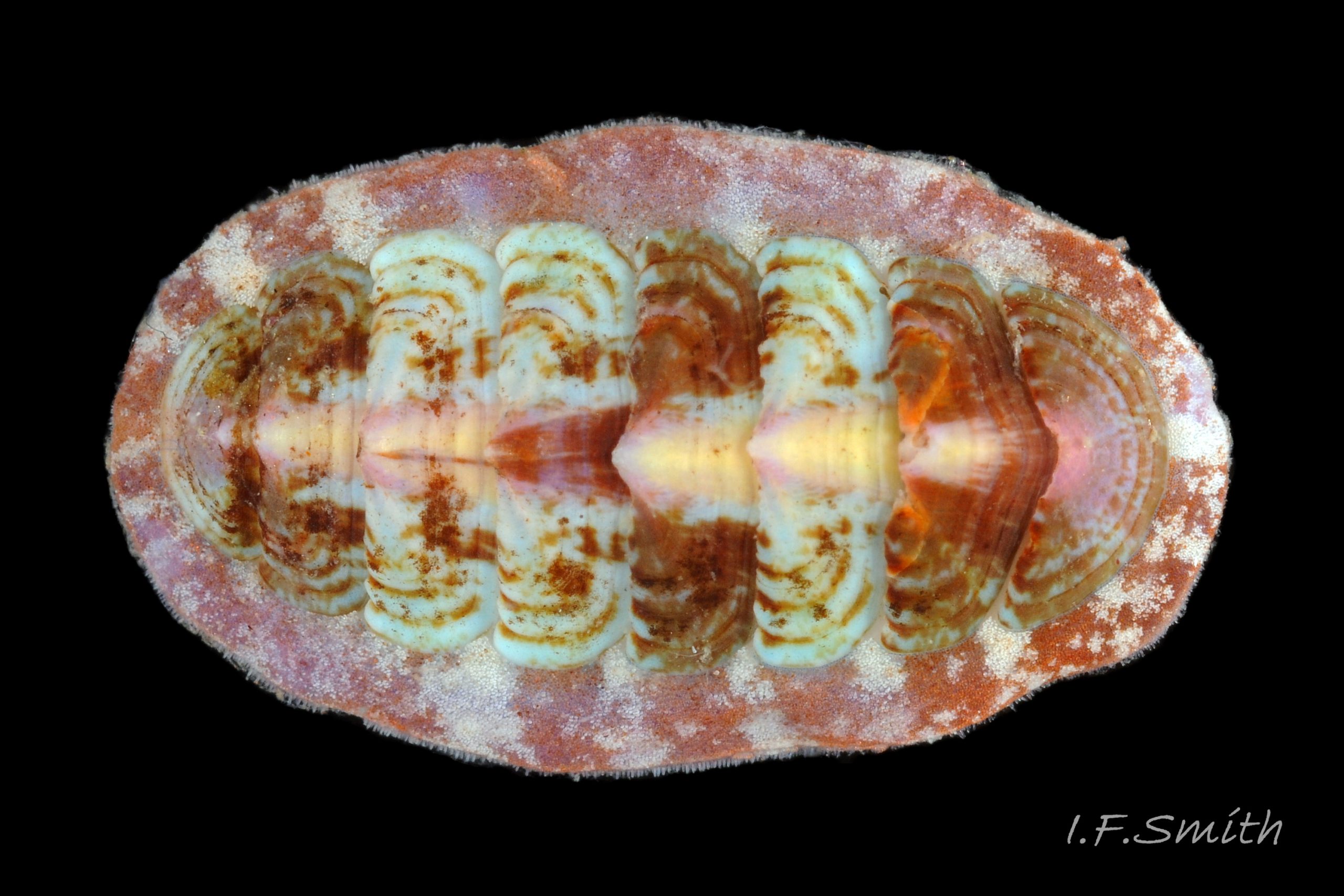Length 12 mm. North Yorkshire. September 2014. (leg. Paula Lightfoot).
Outline elliptical, width about 60% of length. Head on right of image. Girdle occupies 32% of width in this perpendicular view (Jones & Baxter state 20-30%).
KEY ID FEATURES and similar species below.
Key identification features
·Boreochiton ruber (Linnaeus, 1767).
·At LWS and sublittorally.
·Dorsal surface of valves smooth apart from growth lines. (Faint stippling may be visible at X30 magnification.) 17Tr 17 Boreochiton ruber COMPARISON Tonicella marmorea .
·Apophyses on intermediate valves are prominent and rounded, often almost semicircular. Wide jugal sinus (gap between them) is about same width as one apophysis. 17Tr 17 Boreochiton ruber COMPARISON Tonicella marmorea .
·Dorsal surface of girdle has densely-packed, elongate (50 – 60μm), club-shaped granules with packed touching heads giving a mealy appearance. 14Tr 14 Boreochiton ruber .
·Girdle usually has alternating dark and pale transverse bands. Pale bands, often fragmentary, usually thinner than dark bands, and roughly in line with shell-sutures 2Tr 02 Boreochiton ruber .
·Dorsal surface of valves ii – vii makes an arch with smoothly-curved or flattish sides when viewed in profile from posterior 5Tr 05 Boreochiton ruber . Arch distinctly lower than that of Lepidochitona cinerea, but similar to that on T. marmorea.
·about 12 ctenidia each side (range 10-15), arrangement merobranch 12 Tr 12 Boreochiton ruber .
Similar species
For distinguishing from small T. marmorea (length 21mm or less), underwater photographs may not be sufficient; counting of ctenidia, careful disarticulation of specimen and examination under magnification may be required.
·Tonicella marmorea O. Fabricius, 1780.
·At LWS and sublittorally.
·Dorsal surface of valves has growth lines and, at above c. X3 magnification, numerous distinct small granules 17Tr 17 Boreochiton ruber COMPARISON Tonicella marmorea . (Granules, not as large as on L. cinerea, may not be discernible in underwater images or on specimens before deposits and properiostracum removed.)
·White apophyses on intermediate valves are short (anterior-posterior), wide and gently curved (). Narrow jugal sinus (gap between them) is about quarter width of one apophysis. 17Tr 17 Boreochiton ruber COMPARISON Tonicella marmorea . (Note, apophyses in 4 in Kaas & Belle appear to be worn/damaged to stronger curve. Fig.19 in Jones & Baxter shows un-damaged apophyses more accurately.)
·Dorsal surface of girdle has sparse minute granules(c.27μm long) that do not touch each other. (Usually escape notice in photographs.)
·Girdle variably coloured and patterned; deep purple-red to green and may have orange bands; some may resemble T. rubra.
·Dorsal surface of valves ii – vii flat or weakly convex upper slope, separated by hip from slightly concave lower slope 05 Lepidochitona cinerea COMPARISON Boreochiton ruber and Tonicella marmorea. . Low arch, similar height/width ratio to T. rubra.
·17 – 26 ctenidia each side, arrangement merobranch.
·Not found in Britain further south than North Wales or Northumberland. (Many erroneous records on mapping schemes as easily confused with B. ruber.)
Lepidochitona cinerea (Linnaeus, 1767).
1. Only chiton species likely to be found higher than MLW on British shores. Has diverse colour forms 21Br 21 Boreochiton ruber COMPARISON L. cinerea , some similar to B. ruber. 22Br 22 Boreochiton ruber COMPARISON Lepidochitona cinerea . Usual maximum length 16mm, occasionally 28mm.
2. Dorsal surface of valves has numerous rounded, sometimes slightly elongated, granules visible at X5 magnification 23Br 23 Boreochiton ruber COMPARISON Lepidochitona cinerea
3. White apophyses on intermediate valves are gently curved. Wide jugal sinus (gap between apophyses) on intermediate valves is about same width as one apophysis 17Br 17 Boreochiton ruber COMPARISON Tonicella marmorea
Dorsal surface of girdle has densely packed rounded granules 23Br 23 Boreochiton ruber COMPARISON Lepidochitona cinerea .
4. Girdle usually has alternating dark and light transverse lozenge-like bands of approximately equal size. Usually, dark bands have narrow waist, and light bands have a wide waist 24Br 24 Boreochiton ruber COMPARISON Lepidochitona cinerea (sometimes colours interchanged). A thin paler greyish longitudinal line often runs across the waist of bands. Usually a dark central spot on pale bands and white spot somewhere on dark band. Markings can be partial, indistinct, or absent on pale specimens.
5. Valves moderately highly arched; valve 5 height about 32% of width; distinctly higher than that of B. ruber 5Br 05 Boreochiton ruber
6. Usually 16 – 19 gills each side, arrangement holobranch.

